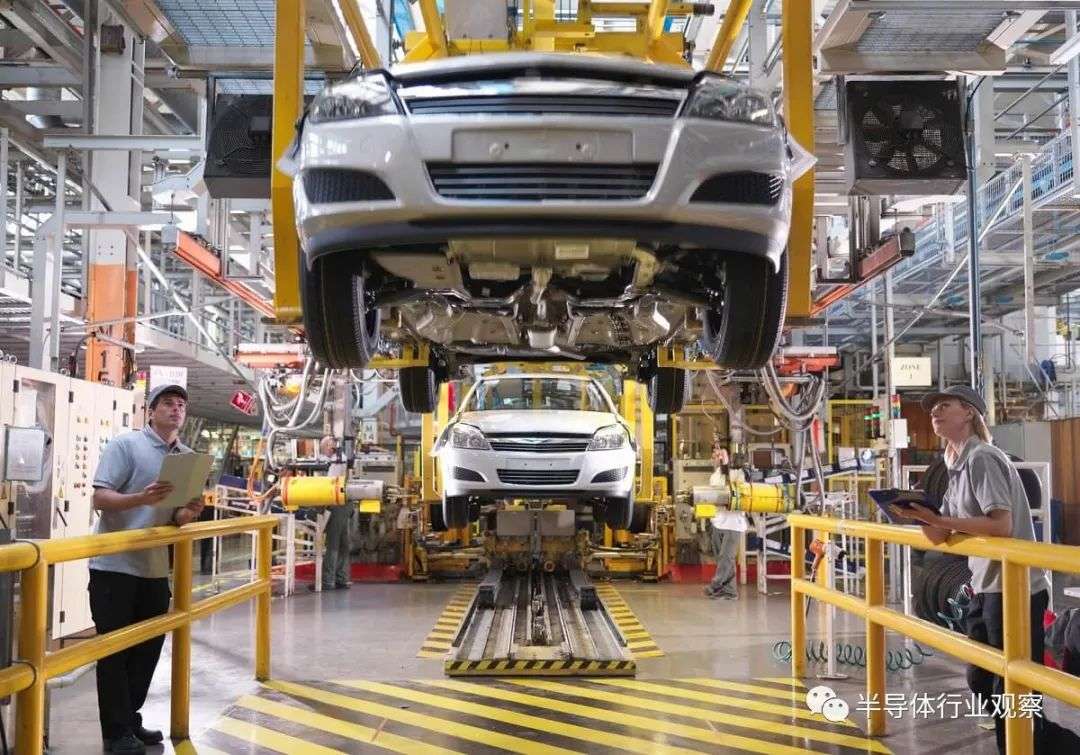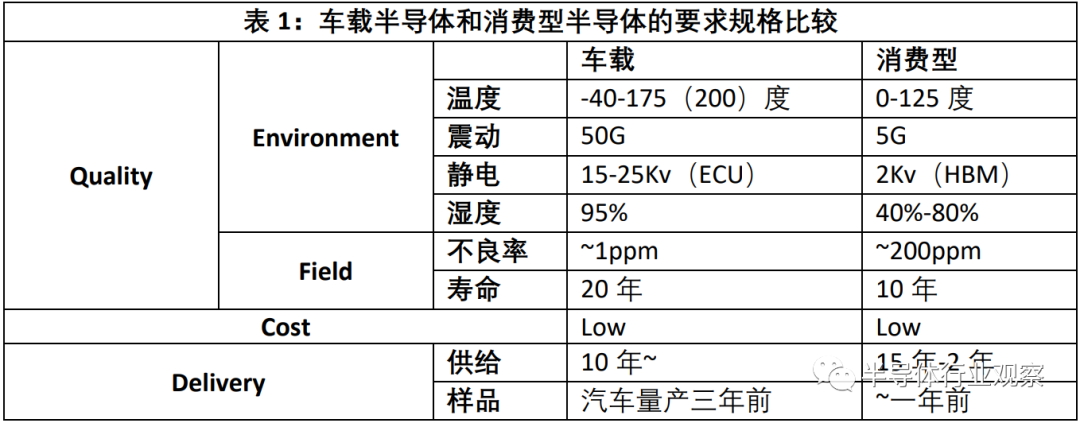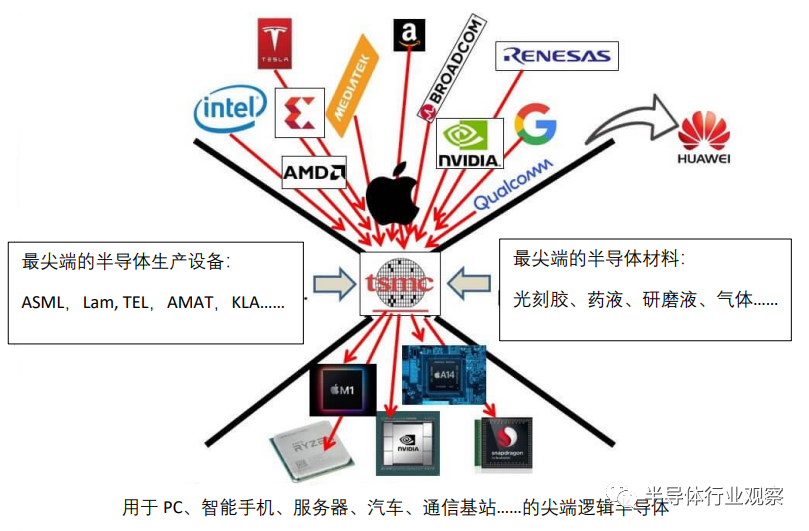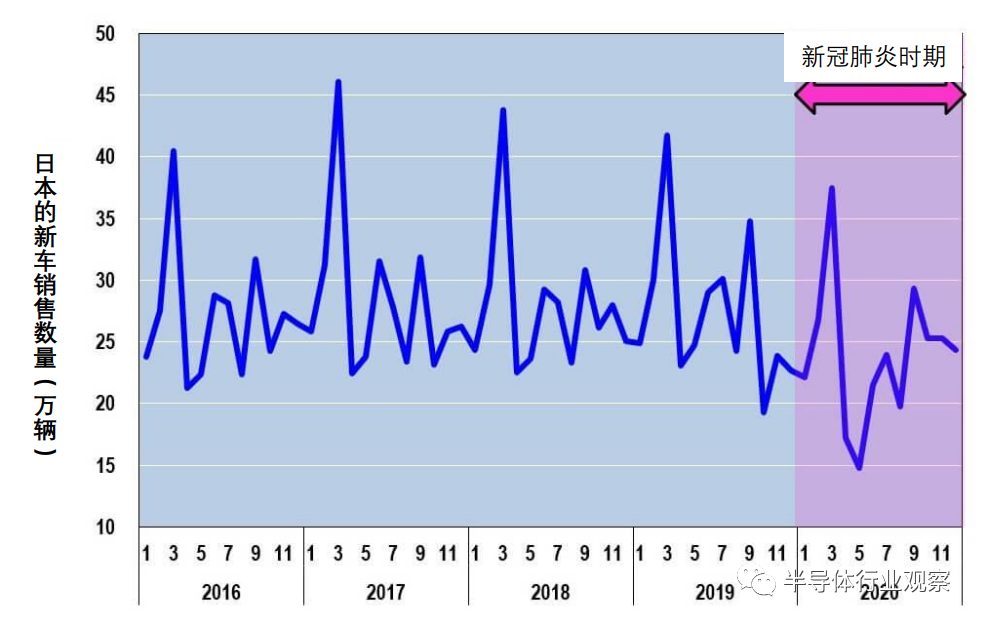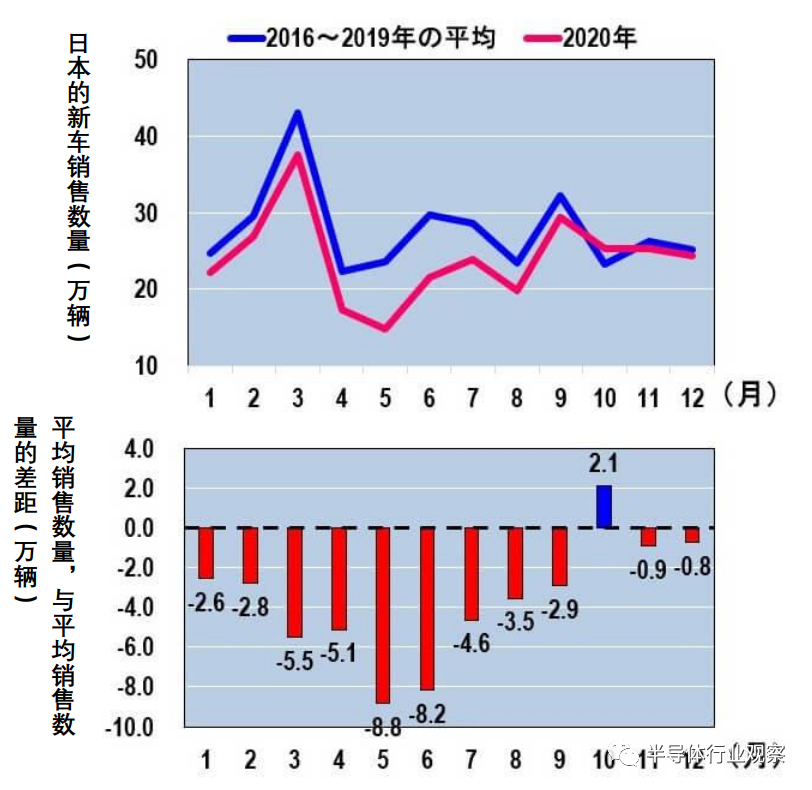To solve the problem of insufficient supply of automotive semiconductors, it can be predicted that it will take at least half a year to a year.
Editor’s note: This article is from the micro-channel public number “Semiconductor Industry observers” (ID: icbank), Author: Tom Long on.
Source: The content is compiled from “biz-journal” by the semiconductor industry observation (ID: icbank), author: Tang Shanghanglong
The global outbreak of new crown pneumonia in 2020 hits the automotive industry directly. Automobile demand “evaporates”, and factories of various auto companies around the world have ceased operations. It was originally thought that market demand and automobile production would recover in the second half of 2020. In 2021, the supply of clinker will be insufficient, and automobile manufacturers will once again fall into the dilemma of reducing production.
First of all, Honda Motor announced on January 7 that due to insufficient supply of semiconductors for vehicle control systems, it reduced production in January by about 4,000, including the small car “Fit” (January 8 Nikkei) . Secondly, Nissan Motor announced on January 8 that due to problems in the procurement of electronic products (including semiconductor components), it will reduce the production of 5,000 cars “NOTE” (January 9 Nikkei).
Picture from: biz-journal
The Nihon Keizai Shimbun also published the following article on the same day. Toyota Motor announced on January 8 that due to semiconductor procurement problems, it has reduced the pickup truck produced by the US factory-“Tundra”. Over the years, Toyota Motor will explain to its parts suppliers its production plan for the next year at this time, but this year only announced the “tentative value”, which is really rare.
In addition, the Nikkei article also pointed out that not only Japanese car companies such as Honda, Nissan, and Toyota, but also European and American vehicles such as Ford, General Motors, Fiat Chrysler Automobiles, and Volkswagen are reducing production. Companies have also reduced or adjusted production due to insufficient semiconductor supply.
Why is there insufficient supply of automotive semiconductors?
A previous article pointed out the reasons for the insufficient supply of automotive semiconductors as follows: “Due to the popularity of electric vehicles (EV) and driverless cars, the demand for automotive semiconductors is soaring”, “The semiconductor usage of an EV is a gasoline car.”Twice the cost”, “The’home’ brought about by the new crown pneumonia has promoted the expansion of semiconductor demand in the direction of PCs and smartphones”, “The world’s largest semiconductor foundry, Taiwan TSMC’s cutting-edge product orders have been covered for six months later.” Therefore, “It will take nearly half a year to restore the supply of automotive semiconductors to normal.”
However, the above content can hardly be the reason for the shortage of global automotive semiconductor supply. Therefore, the author elaborates on the reasons for the insufficient supply of automotive semiconductors in this article. At that time, the author will also cite the following case study (Case Study): Due to the Great East Japan Earthquake that occurred on March 11, 2011, an automotive semiconductor factory in Ibaraki Prefecture, Renesas Electronics’ Naka Factory, was damaged. Secondly, reveal the real reason for the current shortage of automotive semiconductor supply. Finally, I propose the author’s prediction that it will take at least six months or even 1-2 years to solve the problem of automotive semiconductor supply.
The particularity of automotive semiconductors
Table 1 below is a comparison table of the required specifications of automotive semiconductors and those used in consumer electronics such as general digital home appliances. That is, although this table is from the “Fifth Reliability Forum” (host: Nikkei Micro Device) released by Denso on September 1, 2008, it is not out of date even today.
The form comes from: Information from the 5th Nikkei Micro Device Reliability Forum. September 1, 2008
As can be seen from Table 1, automotive semiconductors can guarantee 20 years of quality in the following environments: temperature of -40-175 (200) degrees, humidity of 95%, intense vibration of 50G, static electricity of 15-25Kv, The defective rate is only 1ppm (parts per million). And the price is set as “Low”. That is, compared with consumer semiconductors, automotive semiconductors have extremely high reliability.
However, according to the technical personnel engaged in the production of on-board semiconductors at the Renesas Naka factory, the car manufacturers are not only asking for one part per million, but for “zero defect rate”! Even a small in-vehicle semiconductor may cause a traffic accident and cause death. Therefore, “zero defect rate” must be guaranteed! Whether it is to produce 1 million products or 10 million products, 100% yield must be guaranteed! Therefore, there is no “defect rate ppm”This definition. Must have “zero defect rate”.
The above requirements are understandable, but they cannot be achieved. Because it is impossible to make mass-produced industrial products reach 100% yield! Therefore, the above requirements can be achieved under ideal conditions, but it is not suitable for industrial products.
However, Renesas’ Naka factory does require a “zero defect rate”. Moreover, in order to achieve “zero defect rate”, when manufacturing automotive semiconductors, Toyota and other automakers have implemented “production line certification” for Renesas’ semiconductor plants.
What is “Production Line Certification”?
For example, Renesas’ Naka plant has specially developed a set of 500 processes to produce Toyota’s Engine Control Unit (ECU). Based on this process, Renesas will continue to produce ECUs for half a year to one year. When Renesas can stably produce ECUs that work normally, Toyota will “certify” the Renesas production line. In addition, in principle, the production equipment and process conditions cannot be changed for a 500-process process that has been granted “production line certification”.
As far as Renesas is concerned, even in order to “harmoniously” coexist with other products, adjust production plans with other factories, promote miniaturization, increase yield, increase output, etc., and hope to transform the production line, The automobile manufacturer as the customer will not agree to the replacement of equipment and process conditions. Against this background, if the equipment and process conditions are replaced, which leads to defects, and as a result, causes the problem of automobile accidents, “who is responsible”?
Under the above harsh constraints, it has been recognized by automakers to produce automotive semiconductors with an ultra-high level of trust, and the price must be “Low”. Therefore, I have heard the truth from Renesas technicians: ” In fact, we really don’t want to produce automotive semiconductors”!
Resana Naka Factory damaged by the Great East Japan Earthquake
Resana Naka’s factory, which was “certified” by Toyota Motor Corporation, was hit by the Great East Japan Earthquake on March 11, 2011. A large number of production equipment was destroyed and cracks appeared on the walls of the clean room. As a result, Renesas’ Naka plant can no longer produce ECUs for Toyota, and Toyota can no longer produce the “PRIUS” hybrid car.
Finally, Toyota and Denso dispatched approximately 2,500 employees to support the restoration of the Resano Naka plant. At that time, Toyota’s ECUs were produced by the 0.18um process on the 8-inch production line of the Renesas Naka plant. In addition to the Naka factory, Renesas’ Saijo, Shiga, Kawajiri, and Singapore plants all have a 0.18um 8-inch production line, which can replace the Naka factory.
However, neither Renesas nor Toyota intends to be replaced by other factoriesProduction, insist on restoring the damaged Naka factory. I heard that the reason is “identification of production line.” In other words, if Toyota produces ECUs for Toyota at factories other than the Naka factory, it will need to perform the “production line certification” again, and it will take another six months to one year. Therefore, they believe that it will take less time to repair the damaged production line of the Naka factory than the new “Product Line Approval”.
As a result, whenever a highly reliable automotive semiconductor is to be produced, the auto manufacturer stipulates that it must take half a year to a year for “production line certification.” In addition, even if a problem occurs in a semiconductor factory, it will not be easily transferred to other semiconductor factories for production.
After 28 nanometers, it will be manufactured by TSMC
In the 45-40 nanometer generation, Renesas will design and manufacture in-house. However, with the development of miniaturization, R&D expenses and equipment investment have become more and more expensive. Therefore, Renesas only designs on-board semiconductors after 28nm and entrusts them to TSMC for foundry production (Nikkei Shimbun on March 26, 2018).
In other words, the automotive semiconductors using the traditional 45-40nm process are produced by Renesas itself, and the automotive semiconductors that require cutting-edge processes after 28nm are all entrusted to TSMC for production, that is, Renesas becomes a semiconductor called “Fab Lite” factory. (Figure 1 below)
Figure 1: TSMC’s technology nodes and Renesas’ outsourced production. (Picture from: The author summarized this picture from TSMC’s 2019 Business picture.)
At that time, the author also specifically asked the relevant person of Renesas: “Does TSMC’s semiconductor factory also need a ‘production line certification’”. Renesas’ answer is “Of course it is necessary. TSMC’s automotive semiconductor production line has already obtained the qualification for “Production Line Certification”.
Changes in automotive semiconductors
In recent years, automotive semiconductors have undergone tremendous changes. When the Resana Naka plant was hit by the Great East Japan Earthquake in 2011, Toyota’s ECU used an 8-inch 0.18-nanometer process (described above). In other words, most of the automotive semiconductors a decade ago were produced using traditional processes, and cutting-edge processes were rarely used. This is because in terms of the production of automotive semiconductors, traditionalArt can meet the requirements, and due to the strict requirements of automobile manufacturers, it is difficult to develop new processes. However, in the past few years, the automotive industry has ushered in the tide of CASE (Connected, Autonomous, Shared & Services, Electric), and has entered a period of great change once in a century. As stated at the beginning of this article-“The use of semiconductors in an EV is twice that of a gasoline car”, the number and types of semiconductors used in vehicles are increasing year by year.
In particular, “C” and “A”, that is, networked driverless cars are gradually becoming popular. Such cars need to be equipped with communication semiconductors produced by cutting-edge technology (in line with 5G communication specifications, such as Qualcomm’s Base Band Processor, baseband Processor). In addition, to run this driverless car, artificial intelligence (AI) semiconductors produced by cutting-edge technology (for example, NVIDIA’s GPU in the United States) are required.
In short, with the advent of the CASE era, not all automotive semiconductors can be produced by traditional processes. 5G communications and AI semiconductors must be produced by TSMC’s 7nm, 5nm and other cutting-edge processes.
TSMC’s cutting-edge technology is in short supply
TSMC mass-produced 7nm in 2018, started the 7nm+ process using the most advanced exposure equipment EUV in 2019, started 5nm mass production in 2020, and started 3nm risky mass production this year (2021). The formal mass production of 3nm is planned for 2022, and it is said that 2nm production equipment and materials for mass production in 2024 are currently under preparation.
As mentioned above, TSMC is at the forefront of global cutting-edge miniaturization, but its production capacity is seriously insufficient. In other words, Apple, Qualcomm, AMD, NVIDIA, Broadcom, Xilinx, MediaTek and other global Fabless all hope to design the most advanced semiconductors and entrust them to TSMC for production. (Figure 2 below)
Figure 2: Fabless is engaged in a “competition” around TSMC’s cutting-edge technology.
In addition, Intel led the world’s most advanced miniaturization technology until 2015. Since the failed launch of Ten Nano in 2016, it has been “staying in place”. As a result, IntelAlmost entrusted the production of products beyond 7nm to TSMC. This is also one of the reasons why TSMC’s cutting-edge process capacity is tight.
In addition, automotive semiconductor manufacturers such as Renesas are also caught in a vortex competing for TSMC’s cutting-edge process capacity. What impact has the outbreak of new crown pneumonia in 2020 on TSMC’s automotive semiconductor production?
The impact of new crown pneumonia on the auto industry
Figure 3 below is a chart of the number of new car sales in Japan from 2016 to 2020. The monthly number of new car sales fluctuates greatly, but it is understandable that there will be a peak in March at the end of each fiscal year. In 2020, affected by the new crown pneumonia, many auto manufacturers have cut production and suspended operations. It can be seen from Figure 3 below that the number of new car sales in 2020 is sluggish.
Figure 3: Japan’s new car sales (statistics) number (2016-2020)
(Picture from: The author made this picture based on the statistics of the Japan Automobile Sales Association. )
Number of new cars sold in Japan (10,000 units)
Here, after comparing the average monthly sales volume of new cars from 2016 to 2019 (hereinafter referred to as the average number) with the sales volume in 2020, the upper part of Figure 4 below is obtained. In addition, the author made the difference between the two (that is, how far the average monthly sales volume in 2020 has fallen) into the lower half of Figure 4 below.
Picture 4: 2016-201The 9-year average sales volume compared with 2020, and the gap.
(The picture comes from: The author made this picture based on the statistics of the Japan Automobile Sales Association Federation.)
As a result, the number of new car sales fell by more than 50,000 from March to April of 2020, and by more than 80,000 from May to June. The downward trend was eased after July. The super-average sales volume in October was approximately 21,000, which can be said to have completely recovered.
Based on the above situation, this year (2021) all automakers should produce new cars as planned. However, as mentioned at the beginning of the article, due to insufficient supply of automotive semiconductors, global automakers are forced to reduce production. So, are automotive semiconductors really in short supply?
TSMC’s shipment amount of various semiconductors
Figure 5 below shows the shipment value of various semiconductors of TSMC. First of all, since the second half of 2018, semiconductors for smartphones accounted for about 50% of TSMC’s shipments. Among them, include smartphone application processor (AP), 4G&5G communication semiconductors, etc. One of the largest customers is the US Apple, which sells iPhones.
Figure 5: TSMC’s various semiconductor shipments accounted for the proportion of shipments. (Picture from: Biz-journal)
In addition, from the above figure, we can see that entering 2020, the proportion of High Performance Computing will increase significantly. The main reason is that the new crown pneumonia has caused the popularization of remote office around the world, and people have to stay at home, which has led to a substantial development of online shopping and high-performance game consoles. For example, with the popularization of remote office, PC demand expands, which promotes the business expansion of American processor manufacturer AMD (which will be entrusted to TSMC OEM). In addition, due to the substantial growth of communication data on a global scale, cloud service companies such as Amazon, Microsoft, and Google have also begun to actively build data centers. Their data centers require a large number of servers, and these servers need to be equipped with high-performance processors. . Therefore, the proportion of High Performance Computing has increased significantly.
TSMC’s share of automotive semiconductors
On the other hand, the proportion of automotive semiconductors (Automotive) in TSMC’s shipment value is not very high. The first and second quarters of 2020 will be 4%, and the third and fourth half of 2020. The period fell to 2%. The main reasons are as follows: automakers are affected by the new crown pneumonia, especially during the period from May to June 2020, automakers have drastically reduced the production of new cars (see Figure 4), so they have drastically reduced their orders for automotive semiconductors issued to TSMC .
Automobile manufacturers represented by Toyota adopt the “Just In Time” business method and try their best to reduce inventory levels. In addition, as far as the production of semiconductors is concerned, it takes about 2-3 months to go through 500 processes from wafer entry to the factory (for advanced products, approximately 1,000 processes are required). For example, if it is known in advance that the number of new car sales in March each year will double, the required automotive semiconductor orders will be issued at least half a year ago.
However, due to the sudden onset of new crown pneumonia, automakers were unable to produce new cars as planned, so they significantly reduced their orders to TSMC. As a result, TSMC’s automotive semiconductor shipments accounted for a half in the third and fourth half of 2020, falling to 2%. What actions did TSMC take in response to this?
Why is there insufficient supply of automotive semiconductors?
In the second half of 2020, the utilization rate of TSMC’s automotive semiconductor factory should be far below normal. However, advanced Fabless manufacturers have endless demand for foundry of TSMC. As TSMC, it should not let those factories with low utilization rate idle, but will arrange the production of 5G and AI semiconductors required by Fabless in these factories.
Therefore, it can be inferred that the original dedicated factory for automotive semiconductors will instantly switch to the production of “other cutting-edge semiconductors.” Moreover, the production of “other cutting-edge semiconductors” takes 2-3 months, during which time it is impossible to switch back to automotive semiconductors. This is the first reason for the insufficient supply of automotive semiconductors.
Secondly, even if the production of “other cutting-edge semiconductors” is completed within 2020 and is again transferred to the production of automotive semiconductors, it will take 2-3 months to complete the wafer process. Therefore, during this period, car manufacturers were unable to purchase automotive semiconductors. This is the second reason for the insufficient supply of automotive semiconductors.
When can the shortage of automotive semiconductor supply be resolved?
In addition, factories that have already produced “other cutting-edge semiconductors” may not be able to quickly switch back to producing automotive semiconductors. There are two reasons.
First of all, “Other tip semiconductors”Semiconductors” (for example, semiconductors used in 5G, High Performance Computing, etc.) are in great demand, and profit margins are high (at least they do not need to be as highly reliable as automotive semiconductors, and do not require “production line certification.” ), therefore, TSMC is likely to give priority to economic benefits and temporarily not produce automotive semiconductors in those factories. In this case, TSMC needs to build automotive semiconductor factories in other places, starting from scratch, “production line certification”, at least It takes 1-2 years.
Secondly, after the production of “other cutting-edge semiconductors”, if you switch back to the production of automotive semiconductors, you may not be able to produce finished products immediately. When producing “other cutting-edge semiconductors”, although there is no need to replace equipment, the process conditions will be greatly adjusted. For equipment with a vacuum chamber (such as dry etching equipment, CVD equipment, sputtering equipment, etc.), its interior is likely to change.
Therefore, even if it takes 2-3 months to try out automotive semiconductors, it is still necessary to confirm whether it can meet the specifications in Table 1 above. At this time, if the automotive semiconductors that meet the requirements cannot be produced, 500-1,000 processes need to be re-developed. Therefore, it will take at least six months to one year to obtain the “Production Line Certification” again.
To sum up, to solve the problem of insufficient supply of automotive semiconductors, it can be predicted that it will take at least half a year to a year (or even 1-2 years). It can be said that the Nikkei article “It takes half a year to restore the supply of automotive semiconductors” is also a more optimistic view. For many automakers, the situation is not optimistic.
